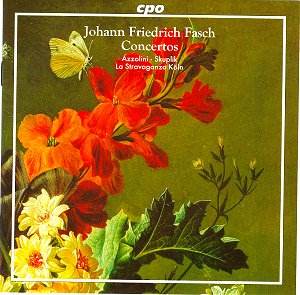Johann Friedrich Fasch
was a contemporary of Johann Sebastian
Bach, and that has seriously hampered
the interest in his music. It was the
German musicologist Hugo Riemann, who
at the beginning of the 20th century
made an attempt to restore his reputation.
In his own time he
was a man of fame, whose works were
known far beyond the regions where he
worked. One of the most important of
these was the time he spent in Leipzig.
He became a member of the Thomasschule
at the age of 13. He came under the
influence of Georg Philipp Telemann,
who arrived in Leipzig at the same time.
Fasch, who had taught himself to play
the keyboard and the violin, started
to compose like Telemann, which he did
with so much success that some of his
works were performed by the Collegium
Musicum. In Leipzig he also got to know
music from elsewhere in Europe, in particular
the concertos of Vivaldi.
In 1708 he started
studying law at Leipzig University,
and founded a second Collegium Musicum,
in which musicians took part who later
ranked among the most famous in Germany.
These included Pisendel, Heinichen and
Stölzel.
From 1712 onwards he
travelled through Germany and worked
in Gera, Greiz and Prague respectively,
until he became Kapellmeister at the
court of Anhalt-Zerbst in 1722. He refused
the invitation to become Thomaskantor
in Leipzig as successor to Johann Kuhnau.
He stayed in Zerbst until his death
in 1758.
As Kapellmeister he
composed a large number of sacred works,
among them nine cantata cycles of which
all have been lost. Only a number of
individual cantatas have survived, as
well as some masses and mass movements.
There is also a Passion on the well-known
text by Brockes.
The main part of his
oeuvre which has come down to us consists
of concertos and overtures. Although
a player of the keyboard and the violin
by profession, one of the features of
his orchestral music is the prominence
of wind instruments, in particular the
oboe and the bassoon. This recording
delivers some excellent examples of
the way Fasch treated these instruments.
In the Overture in
G, for instance, the 'overture' has
the usual ABA structure. At several
moments the orchestra makes way for
a trio of two oboes and bassoon. The
second and, even more so, the fourth
movement (Air I and Air II respectively),
contain passages for violin, oboe and
bassoon. In the last movement (menuet
alternativement) Fasch returns to the
wind trio.
The subject of the
overture is remarkable, and immediately
catches the attention. Just as remarkable
are the two bassoon concertos. The Concerto
in C is very Vivaldian in nature. In
particular the second movement, 'largo
e staccato', has a strongly dramatic
character. In contrast to this concerto
in the Concerto in d minor the solo
and tutti roles are less strictly defined.
It seems it was originally written in
c minor - hence the catalogue number
- with a solo part for a bass instrument,
which could have been the 'basse de
violon' or 'violone'. In the liner notes,
Sergio Azzolini writes: "If one performs
the concerto with another bass instrument
(as in our case, with the bassoon),
then one would choose the key of D minor,
and it is thus that we have done on
the recording of the Concerto a 5. In
this version the solo part goes up to
g', a range occurring in most bassoon
parts by Fasch (...)".
The Concerto a 7 in
c minor is a kind of concerto grosso,
in which the two oboes and the bassoon
are playing the concertino. The Concerto
in A is another nice piece of music
with an expressive solo part for the
violin, in particular in the lyrical
'adagio'.
This recording is a
winner in every respect. It is one of
the very few recordings which is exclusively
devoted to the orchestral music by Fasch.
The orchestra plays quite brilliantly
and the use of dynamics in the overture
is very effective.
The performance of
the wind parts is the most impressive
aspect of this recording. Sergio Azzolini
plays the sometimes very virtuosic solo
parts with verve - the ‘allegro' from
the Concerto in d minor, for instance
- and reaches a high level of expression
in the slow movements. The oboists do
an excellent job as well, making their
contributions pure delight.
Veronika Skuplik gives
a convincing interpretation of the violin
concerto, with clear articulation and
differentiation between the notes. Unfortunately
the recording technique has caused a
slight irregularity at the second entrance
of the violin in the first movement.
Anyone who doubts the
qualities of Fasch’s orchestral music
should listen to this disc. It certainly
makes a passionate plea for the music
of this unjustly neglected master of
the German baroque.
Johan van Veen


